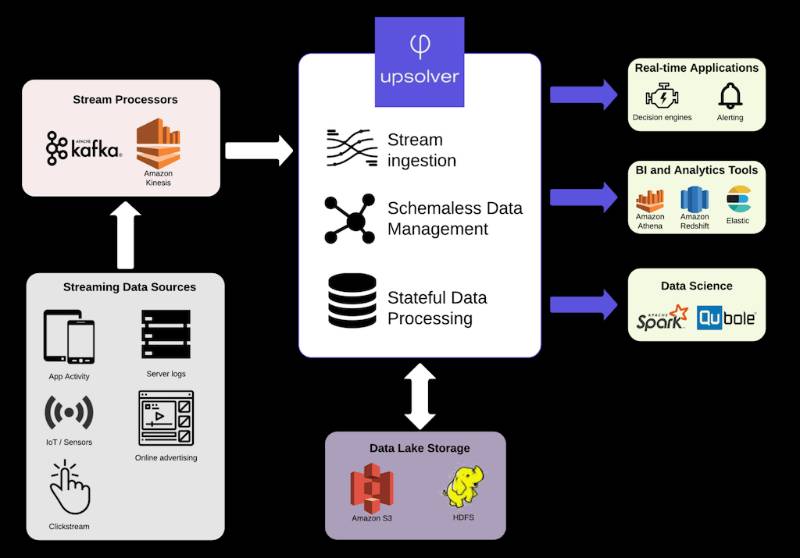1. Introduction & Overview
What is Sensor Data Streaming?

Sensor Data Streaming refers to the continuous collection, transmission, and processing of data generated by robotic sensors in real time. These sensors may include:
- LIDAR for object detection and mapping
- IMUs (Inertial Measurement Units) for orientation and movement
- Cameras for vision and perception
- Temperature, pressure, and force sensors for environment monitoring
Instead of storing data for later analysis, streaming enables real-time decision-making and supports critical RobotOps workflows such as navigation, collision avoidance, predictive maintenance, and remote monitoring.
History or Background
- Early robots (pre-2000s) often worked in controlled environments and relied on offline data collection.
- With the rise of IoT and streaming frameworks (Apache Kafka, ROS topics, MQTT, etc.), robotics shifted to real-time telemetry and cloud-driven analytics.
- In modern RobotOps (operations applied to robotics), sensor streaming has become a backbone for continuous learning, DevOps-driven deployment, and closed-loop control systems.
Why is it Relevant in RobotOps?
- Real-time monitoring: Robots in the field can send live updates for operational visibility.
- Scalability: Hundreds of robots can be managed centrally by streaming telemetry into cloud or edge pipelines.
- Automation: Continuous integration (CI) pipelines can simulate sensor inputs to validate new software releases.
- Safety: Prevents hazards by quickly reacting to environmental changes.
2. Core Concepts & Terminology
Key Terms
- Topic/Stream: A logical channel where data flows (e.g.,
/camera_feed,/lidar_points). - Publisher/Subscriber (Pub/Sub): A messaging model where sensors publish data, and consumers subscribe.
- Serialization: Encoding sensor data into formats like JSON, Protobuf, or ROS messages.
- Latency: The delay between sensor data capture and processing.
- Edge Processing: Handling data locally on the robot before forwarding to the cloud.
Fit in the RobotOps Lifecycle
Sensor data streaming fits into multiple RobotOps phases:
| Lifecycle Stage | Sensor Streaming Role |
|---|---|
| Build & Test | Simulated sensor feeds for testing |
| CI/CD | Automated validation of algorithms against streamed datasets |
| Deploy | Real-time telemetry during rollout |
| Operate | Monitoring fleet performance & anomalies |
| Optimize | Data analytics for tuning robot models |
3. Architecture & How It Works
Components
- Sensors (LIDAR, cameras, IMUs) – raw data producers
- Middleware (ROS, Kafka, MQTT, gRPC) – transports data
- Processing Layer (edge computing nodes, stream processors) – filters, aggregates, transforms
- Storage Layer (time-series DB, data lakes) – long-term retention
- Consumers (dashboards, AI models, monitoring systems) – subscribers to live feeds
Internal Workflow
- Sensor → Publishes raw data
- Middleware → Encodes, routes, and streams
- Processing Node → Performs filtering (e.g., noise reduction)
- Cloud or Edge Analytics → Consumes data for ML/monitoring
- Operator / CI system → Acts based on insights
Architecture Diagram (text-based)
[Sensor Array] ---> [Pub/Sub Middleware] ---> [Edge Node Processing] ---> [Cloud Stream Processor] ---> [Consumers/Dashboards/CI Systems]
Integration with CI/CD or Cloud Tools
- CI/CD: Sensor streaming enables simulation tests before deployment. Example: feeding synthetic LiDAR data into a pipeline for regression testing.
- Cloud Tools: Integrates with AWS Kinesis, Azure Event Hubs, GCP Pub/Sub for large-scale robot fleets.
- Monitoring: Grafana dashboards consume streams for visualization.
4. Installation & Getting Started
Prerequisites
- ROS 2 (Robot Operating System) or a streaming framework (Kafka/MQTT).
- Python 3.8+ or C++11+
- Docker (for containerized setups)
Step-by-Step Setup Guide (ROS 2 Example)
1. Install ROS 2 (Humble)
sudo apt update
sudo apt install ros-humble-desktop
2. Create a ROS 2 Workspace
mkdir -p ~/ros2_ws/src
cd ~/ros2_ws/
colcon build
3. Define a Publisher Node (Python)
import rclpy
from rclpy.node import Node
from std_msgs.msg import String
class SensorPublisher(Node):
def __init__(self):
super().__init__('sensor_publisher')
self.publisher_ = self.create_publisher(String, 'sensor_data', 10)
self.timer = self.create_timer(1.0, self.publish_data)
def publish_data(self):
msg = String()
msg.data = "Sensor reading..."
self.publisher_.publish(msg)
self.get_logger().info(f'Publishing: "{msg.data}"')
rclpy.init()
node = SensorPublisher()
rclpy.spin(node)
node.destroy_node()
rclpy.shutdown()
4. Define a Subscriber Node
class SensorSubscriber(Node):
def __init__(self):
super().__init__('sensor_subscriber')
self.subscription = self.create_subscription(
String, 'sensor_data', self.listener_callback, 10)
def listener_callback(self, msg):
self.get_logger().info(f'Received: "{msg.data}"')
5. Run the Nodes
ros2 run my_package sensor_publisher
ros2 run my_package sensor_subscriber
5. Real-World Use Cases
- Autonomous Vehicles
- LIDAR streams for obstacle detection.
- IMU streams for stability control.
- Industrial Robotics
- Force sensors streaming torque readings for predictive maintenance.
- Healthcare Robots
- Streaming patient vitals to hospital cloud systems in real time.
- Agricultural Drones
- Camera feeds streamed for crop monitoring and pesticide spraying.
6. Benefits & Limitations
Benefits
- Real-time decision-making
- Scalability across fleets
- Improved safety and compliance
- Support for CI/CD testing with synthetic data
Limitations
- High bandwidth consumption (video streams).
- Latency issues in remote/cloud setups.
- Complexity in scaling across distributed robots.
- Security risks if streams are not encrypted.
7. Best Practices & Recommendations
- Security:
- Encrypt streams with TLS.
- Use authentication (JWT, mTLS).
- Performance:
- Apply edge filtering to reduce raw data size.
- Compress high-bandwidth streams (video).
- Maintenance:
- Use observability tools (Prometheus, Grafana).
- Automate stream validation in CI/CD.
- Compliance:
- GDPR/HIPAA for healthcare robots.
- ISO 10218 for industrial robots.
8. Comparison with Alternatives
| Approach | Pros | Cons | When to Use |
|---|---|---|---|
| Sensor Data Streaming | Real-time, scalable, CI/CD friendly | High complexity, bandwidth heavy | Continuous operations |
| Batch Data Collection | Simpler, offline processing | No real-time insights | Training ML models offline |
| On-Device Logging | Low network cost | No central visibility | Edge-only deployments |
9. Conclusion
Sensor Data Streaming is a critical enabler of RobotOps by ensuring that robots remain observable, testable, and responsive in real time. With modern middleware (ROS 2, Kafka, MQTT), robots can publish streams to both edge and cloud for continuous operations.
Future Trends
- 5G-powered low-latency streaming for mobile robots.
- AI-driven adaptive streaming (bandwidth optimization).
- Federated learning using live sensor streams.
Next Steps
- Explore ROS 2 tutorials: https://docs.ros.org
- Join ROS Discourse: https://discourse.ros.org
- Learn Kafka streaming: https://kafka.apache.org